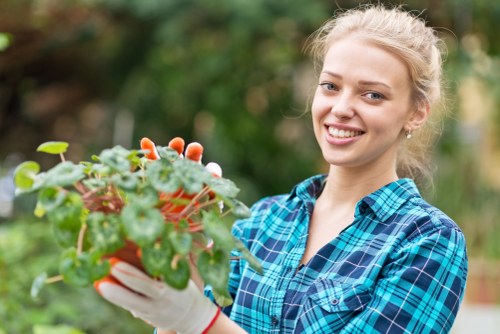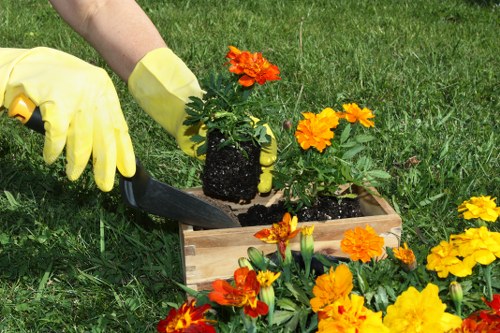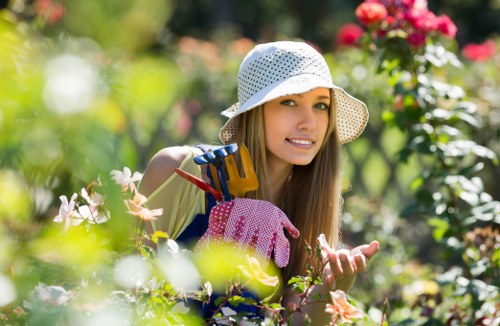Landscape Gardening in Sanderstead
Introduction to Landscape Gardening in Sanderstead

Welcome to the vibrant world of landscape gardening in Sanderstead, where natural beauty meets creative design. Nestled in the heart of Surrey, Sanderstead offers a unique blend of urban convenience and picturesque countryside, making it an ideal location for gardening enthusiasts.
Whether you're a seasoned gardener or just starting out, the landscape of Sanderstead provides ample opportunities to create stunning outdoor spaces. From lush gardens to serene patios, the possibilities are endless.
In this comprehensive guide, we'll explore everything you need to know about landscape gardening in Sanderstead, including design tips, plant selection, sustainable practices, and maintenance strategies to ensure your garden thrives all year round.
Designing Your Sanderstead Garden

Designing a garden in Sanderstead involves understanding the local climate, soil conditions, and the specific needs of your plants. It's essential to start with a clear plan that outlines the layout, plant types, and any hardscape elements you wish to incorporate.
Start by assessing your garden space. Consider factors such as sunlight exposure, soil quality, and drainage. These elements will influence the types of plants you can grow and the overall design of your garden.
Incorporate elements like pathways, seating areas, and water features to add functionality and aesthetic appeal. These features not only enhance the beauty of your garden but also provide practical spaces for relaxation and entertainment.
Understanding the Local Climate

Sanderstead enjoys a temperate climate with mild winters and warm summers, which is ideal for a wide variety of plants. Understanding the local climate is crucial for selecting plants that will thrive in your garden.
Consider the average temperatures, rainfall patterns, and seasonal variations when planning your garden. This knowledge will help you choose plants that are well-suited to the environment, reducing the need for excessive maintenance and ensuring long-term success.
Additionally, microclimates within your garden—such as shaded areas or spots that receive more sunlight—can influence plant selection and placement. Take note of these variations to create a more dynamic and resilient garden design.
Soil Preparation and Management

The foundation of any successful garden is healthy soil. In Sanderstead, the soil composition can vary, so it's important to conduct a soil test to determine its pH level and nutrient content.
Once you know your soil type, you can amend it accordingly. Adding organic matter like compost or well-rotted manure can improve soil structure, enhance fertility, and promote better drainage.
Regular soil management practices, such as mulching and periodic aeration, will help maintain soil health and support robust plant growth. Healthy soil not only benefits your plants but also contributes to the overall sustainability of your garden.
Essential Tools for Gardeners

- Spade and Fork: For digging and turning soil.
- Pruning Shears: Essential for trimming and shaping plants.
- Garden Hose: For efficient watering.
- Wheelbarrow: To transport soil, plants, and tools.
- Gloves: Protect your hands while gardening.
Having the right tools makes gardening tasks easier and more enjoyable. Investing in quality equipment will also ensure durability and efficient performance over time.
Regular maintenance of your tools, such as cleaning and sharpening, will extend their lifespan and keep them in optimal condition for all your gardening activities.
Choosing the Right Plants

Choosing the right plants is a critical step in landscape gardening. In Sanderstead, you have the advantage of a diverse range of plant species that can flourish in the local climate.
When selecting plants, consider factors such as sunlight requirements, water needs, and growth habits. This will ensure that each plant thrives in its designated spot, contributing to the overall harmony of your garden.
Incorporating a mix of perennials, annuals, shrubs, and trees can add texture, color, and structure to your garden. This diversity not only enhances visual interest but also supports local biodiversity.
Native vs. Exotic Plants

Native plants are adapted to the local climate and soil conditions, making them easier to care for and more resistant to pests and diseases. They also support local wildlife, such as birds and beneficial insects.
Exotic plants can add unique colors and textures to your garden, providing a striking contrast to native species. However, they may require more maintenance and specific care to thrive in Sanderstead's environment.
Balancing native and exotic plants can create a visually appealing and ecologically sustainable garden. It's important to research each species' requirements to ensure they fit well within your garden's ecosystem.
Seasonal Planting in Sanderstead

Seasonal planting is key to maintaining a vibrant and dynamic garden throughout the year. In Sanderstead, each season offers unique opportunities for planting and garden transformation.
**Spring** is ideal for planting bulbs, annuals, and perennials, bringing a burst of color and new growth to your garden. **Summer** focuses on maintaining plants, managing water needs, and adding seasonal blooms.
**Autumn** is a time for planting trees and shrubs, as well as preparing your garden for the winter months. **Winter** care involves protecting sensitive plants and planning for the next planting season.
Top Plants for Sanderstead Gardens

- Lavender: Adds fragrance and attracts pollinators.
- Hydrangeas: Offer vibrant blooms in various colors.
- Boxwood: Perfect for hedges and structural elements.
- Hostas: Ideal for shaded areas with lush foliage.
- Japanese Maple: Provides striking foliage and elegant form.
These plants are well-suited to Sanderstead's climate and soil conditions, making them reliable choices for both novice and experienced gardeners.
Incorporate a variety of plant types to create layers and depth in your garden, enhancing its overall aesthetic appeal and functionality.
Sustainable Gardening Practices

Embracing sustainable gardening practices not only benefits the environment but also promotes a healthier and more resilient garden. In Sanderstead, incorporating sustainability into your gardening routine can lead to long-term success.
**Water conservation** is essential. Implementing rainwater harvesting systems and using drip irrigation can significantly reduce water usage while ensuring your plants receive adequate hydration.
Using **eco-friendly materials**, such as recycled mulch or natural fertilizers, minimizes your garden's ecological footprint and supports sustainable living.
Water Conservation Techniques

- Rainwater Harvesting: Collect and store rainwater for garden use.
- Drip Irrigation: Delivers water directly to plant roots, reducing waste.
- Mulching: Helps retain soil moisture and suppress weeds.
- Drought-tolerant Plants: Choose plants that require less water.
- Smart Scheduling: Water plants during cooler parts of the day to minimize evaporation.
Implementing these techniques can lead to significant water savings and a more sustainable garden.
Additionally, monitoring soil moisture levels and adjusting your watering schedule accordingly ensures that your plants receive the right amount of water without excess.
Eco-friendly Landscaping Materials

Choosing eco-friendly materials for your garden enhances sustainability and reduces environmental impact. Opt for natural and recycled materials wherever possible to create a harmonious and responsible garden environment.
Materials such as reclaimed wood, recycled metal, and natural stone are excellent choices for pathways, patios, and garden structures. These options are not only environmentally friendly but also add unique character to your garden design.
Using sustainable materials supports local economies and reduces the carbon footprint associated with manufacturing and transportation, contributing to a healthier planet.
Composting and Soil Health

Composting is a fundamental practice for maintaining healthy soil and promoting sustainable gardening. By recycling kitchen scraps and garden waste, you create rich compost that enhances soil fertility and structure.
Healthy soil is the backbone of a thriving garden. Regularly adding compost improves soil texture, increases nutrient content, and supports beneficial microbial activity. This leads to stronger, more resilient plants capable of withstanding pests and diseases.
Implementing a composting system in your Sanderstead garden is a simple yet effective way to reduce waste and nurture your plants naturally.
Enhancing Your Garden's Aesthetics

Enhancing the aesthetics of your garden involves thoughtful planning and the incorporation of various design elements. Creating a visually appealing garden space can transform your outdoor area into a personal sanctuary.
Focus on balance, symmetry, and focal points to create a harmonious and inviting environment. These design principles guide the eye through the garden, highlighting its best features.
Integrate different textures, colors, and plant forms to add depth and interest to your landscape. A well-designed garden not only looks beautiful but also provides a peaceful retreat from the hustle and bustle of daily life.
Incorporating Hardscapes

- Stone Pathways: Add structure and guide visitors through your garden.
- Patios: Create spaces for outdoor dining and relaxation.
- Water Features: Include ponds, fountains, or waterfalls for a calming effect.
- Garden Walls: Provide boundaries and vertical interest.
- Decking: Offer elevated areas to enjoy your garden from different perspectives.
Hardscapes complement the soft elements of your garden, offering both functionality and aesthetic appeal. Carefully selected hardscape features can enhance the overall design and usability of your outdoor space.
Ensure that hardscape materials harmonize with the natural surroundings to maintain a cohesive and attractive garden environment.
Creating Focal Points

Focal points are essential for drawing attention and creating visual interest in your garden. They serve as anchor points that guide the eye and enhance the overall design.
Common focal points include statues, water features, unique plants, or architectural elements like pergolas and arches. Strategically placing these elements can create a sense of balance and harmony in your garden layout.
Choose focal points that reflect your personal style and complement the existing features of your garden. This personalization makes your garden a true reflection of your taste and creativity.
Lighting for Garden Ambiance

- Path Lighting: Ensures safe navigation through your garden at night.
- Accent Lighting: Highlights specific plants or garden features.
- Ambient Lighting: Creates a warm and inviting atmosphere.
- Solar Lights: Eco-friendly options that reduce energy consumption.
- String Lights: Add a magical touch to outdoor seating areas.
Proper lighting enhances the beauty of your garden after dark, making it a functional and enjoyable space at all hours.
Combining different types of lighting can create layers of illumination, adding depth and dimension to your garden design.
Maintaining Your Sanderstead Garden

Regular maintenance is crucial for keeping your garden healthy and looking its best. Consistent care ensures that plants remain vibrant and that the garden structure is preserved over time.
**Routine tasks** such as weeding, pruning, and watering are foundational to garden upkeep. These activities prevent overgrowth, promote healthy plant development, and maintain the overall appearance of your landscape.
Implementing a maintenance schedule can help you stay organized and ensure that no aspect of your garden is neglected. This proactive approach leads to a more manageable and efficient gardening experience.
Regular Maintenance Tasks

- Weeding: Keeps unwanted plants in check and reduces competition.
- Pruning: Encourages healthy growth and maintains plant shape.
- Deadheading: Removes spent flowers to promote new blooms.
- Mulching: Suppresses weeds and retains soil moisture.
- Fertilizing: Provides essential nutrients for plant health.
By staying on top of these tasks, your garden will remain lush, orderly, and full of life throughout the seasons.
Use high-quality fertilizers and organic options to support sustainable growth and soil health.
Seasonal Care Tips

Caring for your garden according to the seasons ensures that plants receive the appropriate care they need to thrive.
In **spring**, focus on planting new specimens, preparing soil, and starting regular maintenance routines.
During **summer**, monitor water levels, manage pests, and provide support for growing plants to prevent damage from heat stress.
Dealing with Pests and Diseases

- Integrated Pest Management (IPM): A balanced approach to controlling pests.
- Natural Predators: Encourage beneficial insects like ladybugs.
- Organic Pesticides: Safe options for managing pest populations.
- Regular Inspection: Early detection of issues prevents widespread damage.
- Proper Sanitation: Keep the garden clean to reduce disease risk.
Addressing pests and diseases promptly is essential for maintaining plant health and garden aesthetics.
Implementing preventive measures and adopting organic solutions can effectively manage pests without harming the environment.
Final Thoughts on Landscape Gardening in Sanderstead
Landscape gardening in Sanderstead offers a rewarding experience that combines creativity, sustainability, and the natural beauty of Surrey's environment. By following the tips and strategies outlined in this guide, you can create and maintain a stunning garden that enhances your property and provides a peaceful retreat.
Remember to plan thoughtfully, choose the right plants, embrace sustainable practices, and stay consistent with maintenance. These efforts will ensure that your garden remains vibrant and healthy for years to come.
Ready to transform your outdoor space? Contact us today or book your service now to start your landscape gardening journey in Sanderstead.